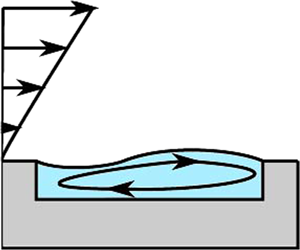Crossref Citations
This article has been cited by the following publications. This list is generated based on data provided by
Crossref.
Liu, Cong
Legchenkova, Irina
Han, Libao
Ge, Wenna
Lv, Cunjing
Feng, Shile
Bormashenko, Edward
and
Liu, Yahua
2020.
Directional Droplet Transport Mediated by Circular Groove Arrays. Part I: Experimental Findings.
Langmuir,
Vol. 36,
Issue. 32,
p.
9608.
Ageev, A. I.
and
Osiptsov, A. N.
2021.
Pulsating Flow of a Viscous Fluid over a Cavity Containing a Compressible Gas Bubble.
Fluid Dynamics,
Vol. 56,
Issue. 6,
p.
799.
Kim, Hae Nyeok
and
Lee, Sang Joon
2021.
Shear-driven drainage of lubricant in a spherical cavity of lubricant-infused surface.
Physics of Fluids,
Vol. 33,
Issue. 12,
Liang, Yuanzhen
Li, Changyang
Wang, Peng
and
Zhang, Dun
2021.
Fabrication of a robust slippery liquid infused porous surface on Q235 carbon steel for inhibiting microbiologically influenced corrosion.
Colloids and Surfaces A: Physicochemical and Engineering Aspects,
Vol. 631,
Issue. ,
p.
127696.
Vega-Sánchez, Christopher
and
Neto, Chiara
2022.
Slightly Depleted Lubricant-Infused Surfaces Are No Longer Slippery.
Langmuir,
Vol. 38,
Issue. 34,
p.
10568.
Rahmani, H.
and
Taghavi, S.M.
2022.
Poiseuille flow of a Bingham fluid in a channel with a superhydrophobic groovy wall.
Journal of Fluid Mechanics,
Vol. 948,
Issue. ,
Ageev, A. I.
and
Osiptsov, A. N.
2022.
Macro- and Microhydrodynamics of a Viscous Fluid on a Superhydrophobic Surface.
Colloid Journal,
Vol. 84,
Issue. 4,
p.
379.
Zhang, Linsheng
Mehanna, Yasmin A.
Crick, Colin R.
and
Poole, Robert J.
2022.
Surface Tension and Viscosity Dependence of Slip Length over Irregularly Structured Superhydrophobic Surfaces.
Langmuir,
Vol. 38,
Issue. 39,
p.
11873.
Henman, Nathaniel I.J.
Smith, Frank T.
and
Tiwari, Manish K.
2023.
Computational study of early-time droplet impact dynamics on textured and lubricant-infused surfaces.
International Journal of Multiphase Flow,
Vol. 161,
Issue. ,
p.
104398.
Shen, Feng
Zhu, Lin
Ji, Deru
Zhao, Siyu
and
Liu, Zhaomiao
2023.
Dynamic evolution of oil–water interface during displacement in microcavities.
Colloids and Surfaces A: Physicochemical and Engineering Aspects,
Vol. 658,
Issue. ,
p.
130698.
Rahmani, H.
and
Taghavi, S.M.
2023.
Viscoplastic flows in thin superhydrophobic channels.
Journal of Non-Newtonian Fluid Mechanics,
Vol. 315,
Issue. ,
p.
105016.
Ray, Prasun K.
Bouvier, Damien
and
Papageorgiou, Demetrios T.
2023.
Flow of shear-thinning liquids in channels with superhydrophobic surfaces.
Journal of Non-Newtonian Fluid Mechanics,
Vol. 319,
Issue. ,
p.
105091.
Rahmani, H.
Kumar, H.
Greener, J.
and
Taghavi, S. M.
2023.
Yield stress fluid flows in superhydrophobic channels: From creeping to inertial regime.
Physics of Fluids,
Vol. 35,
Issue. 8,
Rahmani, H.
and
Taghavi, S.M.
2024.
Viscoplastic flows in superhydrophobic channels with oriented grooves: From anisotropic slip to secondary flow.
Journal of Non-Newtonian Fluid Mechanics,
Vol. 326,
Issue. ,
p.
105203.
Rahmani, H.
and
Taghavi, S.M.
2024.
A comprehensive model for viscoplastic flows in channels with a patterned wall: longitudinal, transverse and oblique flows.
Journal of Fluid Mechanics,
Vol. 984,
Issue. ,
Rahmani, Hossein
Larachi, Faïçal
and
Taghavi, Seyed Mohammad
2024.
Modeling of Shear Flows over Superhydrophobic Surfaces: From Newtonian to Non-Newtonian Fluids.
ACS Engineering Au,
Vol. 4,
Issue. 2,
p.
166.






